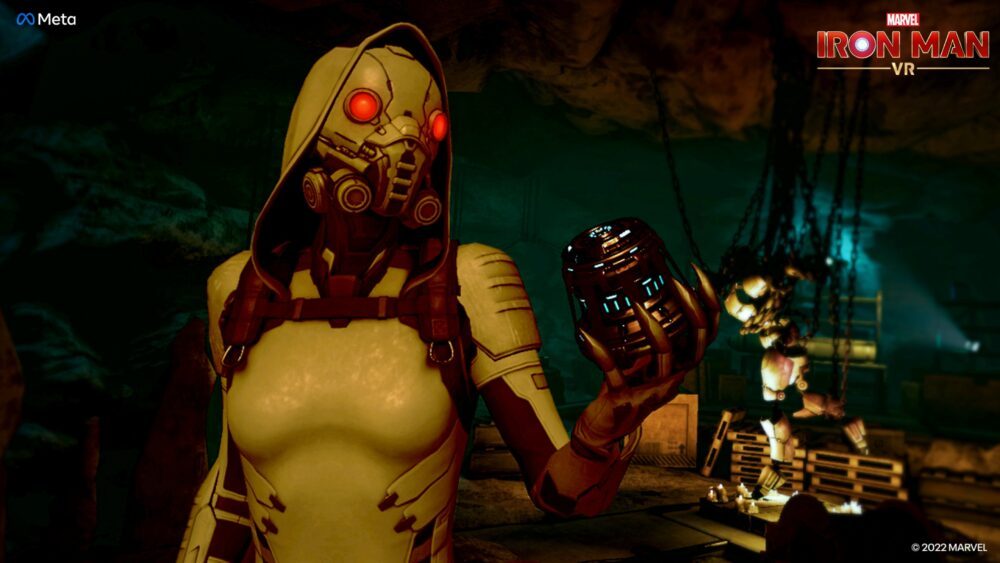The world needs Iron Man. The world needs you. Today marks the launch of Marvel’s Iron Man VR on Meta Quest 2 and Meta Quest Pro. Suit up in Tony Stark’s iconic armor and confront a dangerous new threat before it destroys not just Iron Man, but everything Iron Man stands for.
Marvel’s Iron Man VR is now available on the Meta Quest Store for $39.99 USD! We’ve been big fans of the game since it launched on PlayStation VR in 2020, and we’re beyond excited that the talented teams at Camouflaj and Endeavor One were able to faithfully bring the experience over to Meta Quest 2, along with our partners at Sony Interactive Entertainment and Marvel Entertainment.
We recently sat down with Matt Walker, Executive Producer at Camouflaj, to talk about what exactly went into bringing Marvel’s Iron Man VR to Meta Quest 2, nailing Iron Man’s flight mechanics, lessons learned across multiple VR projects, and more!
First, for those who haven’t played Marvel’s Iron Man VR, what’s the story setup? What’s this incarnation of Tony Stark like, and what threat is he facing?
Matt Walker: Marvel’s Iron Man VR starts with Tony Stark reflecting on his history as a weapons maker while focused squarely on his future as a Super Hero. When a mysterious “Ghost” from his past ambushes him, Tony is forced to reconcile with the damage his weapons caused while also facing off against a version of himself he thought he put in the rearview for good.
What aspects of Iron Man did you know you needed to nail to make the player feel like they were in the armor? And which one proved the hardest to get right?
MW: Right from the start we felt like there’s no better pairing than Iron Man and virtual reality. Positioning Iron Man’s gauntlets to fly and shoot, being immersed in his HUD, and experiencing deep story moments with iconic Marvel characters align perfectly with the unique strengths of VR hardware.
Knowing that, we kicked off development focused on getting the sense of flying as Iron Man just right. Thanks to an early prototype built by one of our gameplay engineers, Troy Johnsen, we quickly realized we had magic on our hands. From the first week of development we all had big smiles on our faces as we flew around as Iron Man at super high speeds.
The freedom of flight we felt early on has carried over to the final product thanks to years of experimentation and fine-tuning. For example, we elegantly angle players around obstacles just as they fly close to deliver the same grace as Iron Man demonstrates in the comics and films.
Once we nailed flight we shifted our attention to getting combat just right. We started by asking ourselves what are the quintessential actions that deliver on the fantasy of being Iron Man. Obviously players want to shoot Repulsors from their palms like Iron Man, but what about melee attacks? From there one of our favorite features was born: being able to Rocket Punch enemies to deliver devastating blows.
From there stemmed another Camouflaj favorite: the ability to Rocket Punch straight down into a three-point landing. We call that Ground Pound. Before we knew it the player had a versatile arsenal to take on any enemy while flying through the air.
Finally, we knew that it would be critical to provide a solid narrative, one that fans and our friends at Marvel could be proud of. Our lead writer, Brendan Murphy, worked directly with Marvel and their frequent collaborator, Christos Gage, to craft a meaningful story focused on the diegetic nature of old Tony as a weapons seller, and new Tony as a Super Hero.

Flight—or really any fast movement—is hard to pull off without overwhelming the player. How did you dial in Iron Man’s unique flight mechanics, and what did you have to consider comfort-wise?
MW: There were a lot of subtle things we did to make flight feel amazing to the player—helping them seamlessly maneuver obstacles as I mentioned earlier is just one example. You’ll also notice that the direction you face has an influence on the direction your repulsors propel you in as well.
The immersive nature of the HUD helped us to ground the player in the experience of being Iron Man, and with Boost, players are given a high degree of freedom to quickly burst in a specific direction. Overall, we found that giving players more direct control over their flight—even at high speeds—led to the most comfort for the player.
Another important aspect is making sure that we’re running at stable frame rates. This is where the Meta hardware really shines. On the off chance the game can’t keep up, Meta’s engineers have developed something called “Asynchronous Time Warp” that allows the headset to remain in sync with the movement of your head. The end result is an amazing experience flying around places like Malibu, Shanghai and a SHIELD Helicarrier in VR!
Can you talk about the technical hurdles that came with porting Marvel’s Iron Man VR to Meta Quest 2? What did it take to get a game of this scope and detail running on a mobile chipset?
MW: We knew it was going to be a significant challenge to realize this great looking game on a mobile chipset which is why we’re so blown away by the work our colleagues did. Inverabily, anyone who plays the game tells us how the game’s visuals on Meta Quest 2 really exceeded their expectations, and I couldn’t agree more.
In many ways the Meta Quest 2 hardware made development easier given the freeing wireless nature of the hardware. It’s really noticeable when you’re flying around Malibu, the first mission in the game, trying to get a fast time on the time trial. The wireless Meta Quest 2 headset allows players to turn and guide themselves past obstacles without getting wrapped up in cables. We also made sure to leverage the power of the Touch controllers to allow for maximum immersion.

While developing Marvel’s Iron Man VR, you also rebuilt Republique for VR. Did you learn anything from that process, either about developing for VR in general or specifically for Meta Quest?
MW: Thank you for bringing up Republique VR! The team deserves a ton of credit for building that game in a way that looks amazing on the earliest standalone VR headsets out there. I still can’t believe the game is powered by a smartphone from 2015 and runs as well as it does.
The biggest lesson from Republique VR that we applied when bringing Marvel’s Iron Man VR to Meta Quest 2 was that we need to use absolutely every tool in our toolbox to make the game look and run great. You really have to leave no stone left unturned and utilize all the incredible tools provided by our friends on the platform and hardware side of the business.
Another important lesson is to do whatever it takes to get the game running on the Quest 2 hardware so as to unblock the rest of the team. It took Camouflaj and Endeavor One engineers about two months to get the game running in a fairly primitive state on Quest 2, but once we passed that milestone, the other disciplines were able to jump in and make huge contributions. The excitement around our (virtual) office was palpable.
Are there any lessons you’ll take away from Marvel’s Iron Man VR that will inform your next project?
MW: Bringing Marvel’s Iron Man VR to Meta Quest 2 and Meta Quest Pro afforded our team an opportunity to deepen our understanding of the hardware and its capabilities. Although I’m still wildly impressed with how good the game looks and plays on the hardware, our team is confident there’s plenty more untapped potential with these devices.
On the creative side, we’re big believers that the rulebook for VR game development is far from complete, so every chance we have to hone our skills and learn more about what works well in VR are things we take with us to our next project.

What’s next for you and the team? Any future plans?
MW: We’re ecstatic to have recently been welcomed as the newest addition to Oculus Studios. It’s been a dream working with all the passionate, understanding professionals here at Meta and working hand-in-hand with different groups across the org. It truly feels like home here.
As far as future plans go, the team at Camouflaj is already deep in development of our next title, which we simply can’t wait to share with you all when the timing is right.
Anything else you’d like to share with our readers?
MW: I just can’t wait to have people try Marvel’s Iron Man VR on Meta Quest 2 and Meta Quest Pro. I think it really represents one of the best use cases for VR—giving people the freedom to experience things first-hand that they would never be able to in real life. In this case, being able to fly around and save the world as Iron Man.
The wireless nature of Meta Quest 2 and Meta Quest Pro really magnifies the freedom of that experience, enabling you to jump right into the action with minimal load times.
We’re proud to bring Marvel’s Iron Man VR to an already robust software library on the Meta Quest platform and to see how players react to this game we put our hearts and souls into.
Ready to don Iron Man’s armor? Marvel’s Iron Man VR is available now on Meta Quest 2 and Meta Quest Pro for $39.99 USD.
- AR/VR
- blockchain
- blockchain conference ar
- blockchain conference vr
- coingenius
- crypto conference ar
- crypto conference vr
- extended reality
- Metaverse
- mixed reality
- Oculus
- oculus games
- oppo
- plato
- plato ai
- Plato Data Intelligence
- PlatoData
- platogaming
- robot learning
- telemedicine
- telemedicine companies
- Virtual reality
- virtual reality game
- virtual reality games
- vr
- zephyrnet












